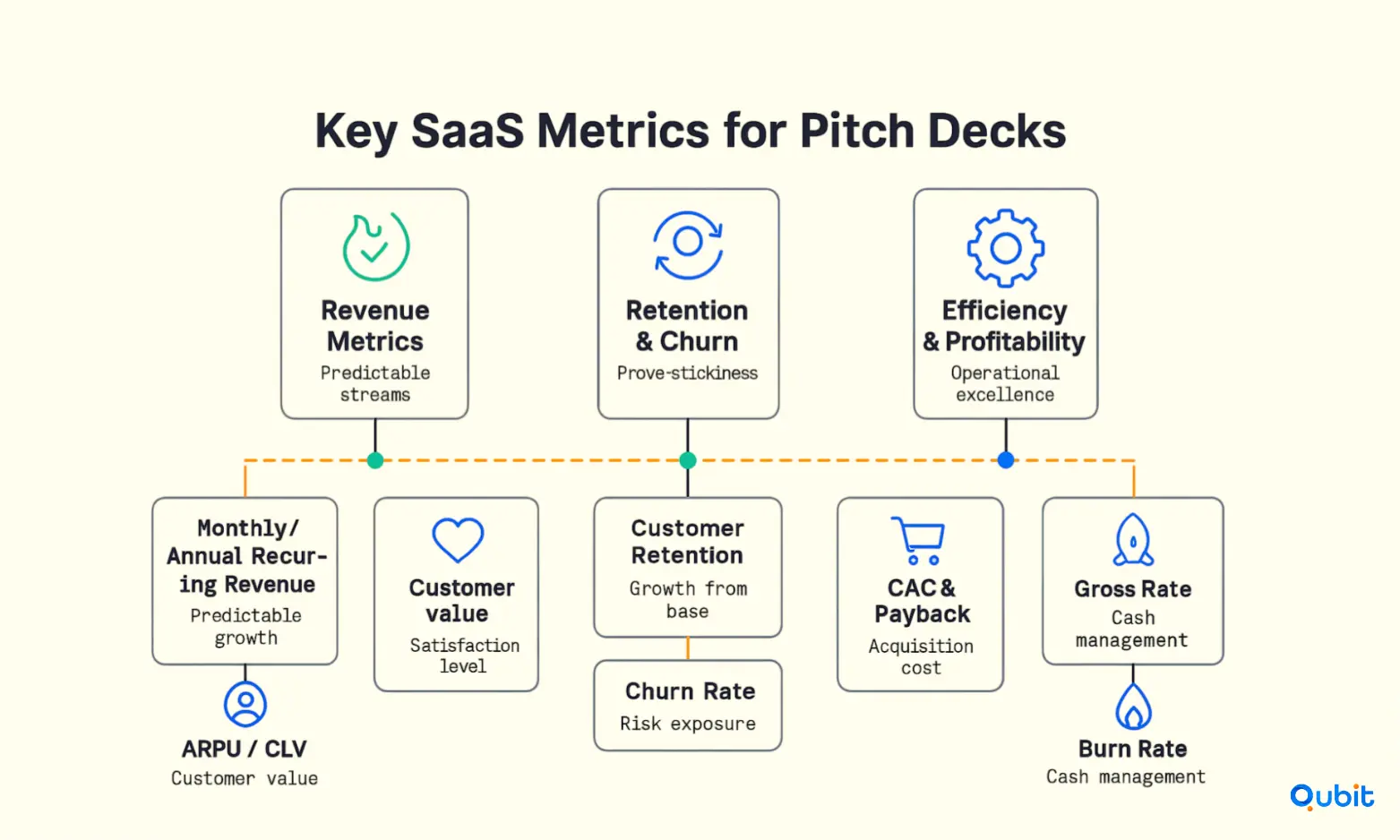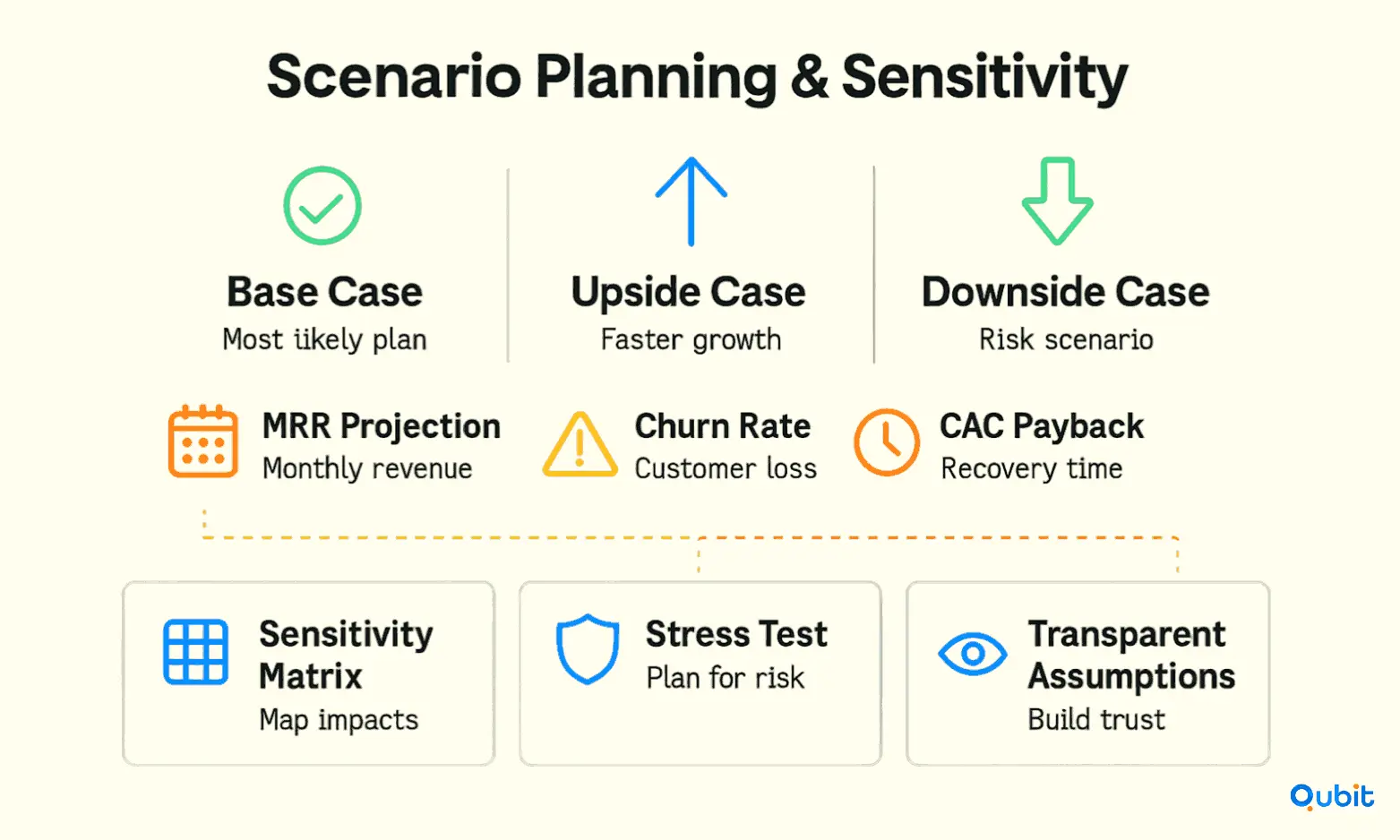If you’re pitching a SaaS business and your financial projections are just a random hockey-stick graph with no supporting metrics, congratulations, you’ve given investors the perfect excuse to say “no.”
Financial projections aren’t just about big numbers to impress the room. They’re proof you understand how your business actually works. Investors expect more than blind optimism, they want to see the engine behind your growth.
With the global SaaS market projected to reach $390.46 billion by the end of 2025, startups must present metrics like Monthly Recurring Revenue (MRR), Customer Acquisition Cost (CAC), and Lifetime Value (LTV) to stand out in this competitive landscape.
This article gives you a glimpse of what to showcase in your saas pitch deck and gain investor's confidence. Let's dive in!
Why Financial Metrics Matter
Before you dive into MRR or CAC calculations, ask yourself: Why bother? Because without hard numbers, your pitch deck is just art, pretty, but pointless.
- Builds Credibility
Investors hear “trust me” all day. Financial metrics are your receipts. Showing a CAC payback of 6 months instead of 12 tells them you’ve done your homework—and you’re not throwing money at a black hole. - Reveals the Health of Your Engine
A soaring revenue curve might look great, but if churn is 10% monthly, you’re scooping water with a colander. Metrics like LTV and gross margin show whether you’re scaling sustainably—or if you’re on a crash course with Reality. - Guides Strategic Decisions
Should you double down on paid ads or switch budgets to content marketing? When you know your CAC by channel and your payback period, you can allocate dollars where they actually move the needle—rather than spraying and praying. - Frames the Investment Ask
“We need ₹2 Cr to grow” is a blank check request. But “We need ₹2 Cr to cut our CAC payback by 3 months and expand into two new markets” is a targeted mission. Investors love clarity about how their capital accelerates your growth.
Key SaaS Metrics for Pitch Decks
Crafting a compelling pitch deck requires more than just a sleek design—it demands a clear narrative supported by key SaaS metrics. These metrics, grouped into categories like revenue, retention/churn, and efficiency/profitability, provide a comprehensive view of your business's performance. Let’s explore these essential metrics and how they can elevate your pitch.

Revenue Metrics: Showcasing Growth Potential
Revenue metrics are the cornerstone of any SaaS pitch deck, as they demonstrate the financial health and scalability of your business. Investors want to see consistent growth and a clear path to profitability. Here are the key metrics to include:
- Monthly Recurring Revenue (MRR) and Annual Recurring Revenue (ARR): These metrics highlight the predictability of your revenue streams. Break them down by customer segments or product tiers to show where growth is coming from.
- Average Revenue Per User (ARPU): ARPU provides insight into how much revenue you generate per customer. A rising ARPU often signals successful upselling or premium product adoption.
- Customer Lifetime Value (CLV): This metric estimates the total revenue a customer will bring over their relationship with your company. Pairing CLV with customer acquisition cost (CAC) can illustrate the profitability of your customer base.
Retention and Churn Metrics: Proving Customer Stickiness
Retention and churn metrics are critical for demonstrating the sustainability of your SaaS business. High retention rates and low churn indicate that customers find value in your product and are likely to stick around.
- Customer Retention Rate (CRR): This metric shows the percentage of customers who continue using your product over a specific period. A high CRR reflects strong customer satisfaction and loyalty.
- Net Revenue Retention (NRR): NRR accounts for upsells, cross-sells, and churn, providing a holistic view of revenue growth from existing customers. An NRR above 100% is a strong indicator of product-market fit.
- Churn Rate: Highlight both customer churn (the percentage of customers lost) and revenue churn (the percentage of revenue lost). Addressing churn in your pitch shows that you’re proactive about mitigating risks.
Your examination of financial indicators is enriched by the focus on product market fit software investors, which explains how to align user metrics with market needs. This alignment strengthens your case for sustainable growth.
Efficiency and Profitability Metrics: Highlighting Operational Excellence
Efficiency and profitability metrics reveal how effectively your SaaS business utilizes resources to generate revenue. These metrics are especially important for demonstrating scalability and long-term viability.
- Customer Acquisition Cost (CAC): CAC measures the cost of acquiring a new customer. Pair this with CLV to show the return on investment for your marketing and sales efforts.
- CAC Payback Period: This metric indicates how long it takes to recoup the cost of acquiring a customer. A shorter payback period is more attractive to investors.
- Gross Margin: Gross margin reflects the profitability of your core operations. A high gross margin indicates that your business can scale efficiently.
- Burn Rate: For early-stage SaaS companies, the burn rate (how quickly you’re spending cash) is a key metric. Pair this with your runway (how long your cash reserves will last) to provide a complete financial picture.
Telling a Cohesive Performance Story
When presenting these metrics, focus on crafting a narrative that ties them together. For example, show how improvements in retention metrics like NRR are driving revenue growth, or how operational efficiencies are reducing your CAC payback period. By connecting the dots, you’ll provide investors with a clear and compelling story of your SaaS business’s potential.
Including these metrics in your pitch deck not only builds credibility but also demonstrates that you understand the key drivers of your business. Complement your pitch deck with insights from software startup fundraising strategies to maximize funding opportunities.
Scenario Planning & Sensitivity Analysis
Blind forecasts are boring, and risky. Show you’ve stress-tested your model with “what-ifs.” Highlight the key levers (e.g., a 1% churn change moves your runway by 2 months).

What to include
- Base case: Your most likely projection.
- Upside case: If growth accelerates (e.g., 20% higher MRR).
- Downside case: If churn or CAC spikes (e.g., 10% worse).
- Sensitivity matrix: Table showing how small changes in churn or CAC affect runway or profitability.
Why it matters
- Demonstrates you’ve thought through risks and won’t be caught flat-footed.
- Helps investors gauge their downside and upside before writing the check.
EXAMPLE:
| Scenario | 12-Month MRR | Churn | CAC Payback | Runway (₹50 L burn) |
|---|---|---|---|---|
| Base | ₹5 L | 5% | 8 mo | 12 mo |
| Upside | ₹6 L | 4% | 6 mo | 14 mo |
| Downside | ₹4 L | 7% | 10 mo | 10 mo |
Your coverage of financial projections can also be paired with guidance from software pitch deck design tips, illustrating how visual storytelling can underscore key metrics. By combining clean data with strong storytelling elements, startups can create a compelling narrative that resonates with investors and stakeholders alike.
Maintaining data integrity is not just about accuracy; it’s about building trust and clarity. Startups that prioritize this aspect are better positioned to secure funding and drive sustainable growth.
Benchmarking & Industry Comparisons
Numbers in isolation are just numbers. Contextualize with industry benchmarks.
- What to include
- MRR growth rates: Compare your month-over-month or year-over-year growth to category leaders (e.g., 10–15% MoM for high-growth SaaS).
- CAC payback: Show where you land versus peers—are you faster, slower, or on par?
- Churn rates: 5–7% annual churn is typical for SMB-focused apps; 2–3% for enterprise.
- Why it matters
- Investors know the averages; beating them is a strong signal.
- If you’re below average, you can still spin it as upside—“we’ve optimized churn by X% since launch.”
- Quick example
- “Our 8% MoM MRR growth outpaces the 6% average in the SMB invoicing category. Our 7-month CAC payback is 2 months faster than the 9-month industry norm.”
- Tip
- Cite public reports (e.g., KeyBanc, Pacific Crest) or benchmarking surveys to back your claims.
Conclusion
Crafting a pitch deck that resonates with investors requires more than just numbers—it demands a compelling narrative supported by accurate financial projections and key SaaS KPIs. Throughout this blog, we’ve explored strategies to refine your financial presentations, emphasizing the importance of clarity and storytelling. By focusing on actionable insights and aligning projections with realistic growth expectations, startups can build trust and credibility.
A well-structured pitch deck not only communicates your vision but also demonstrates your preparedness to scale. Taking the time to refine your approach ensures you’re presenting a cohesive story that investors can connect with.
If you're ready to elevate your pitch deck with accurate financial projections and compelling SaaS KPIs, we at Qubit Capital can help with our Pitch Deck Creation service. Let’s work together to transform your ideas into a presentation that drives results.
KEY TAKEAWAYS
- Investors reject vague hockey-stick projections with no solid metrics.
- Financial metrics build credibility and prove real business understanding.
- Key SaaS metrics include MRR, CAC, LTV, churn, retention, and gross margin.
- Scenario planning shows you’ve stress-tested projections against risks.
- Benchmarking against industry averages adds context and trust.
- Cohesive storytelling ties metrics together for an investor-friendly pitch.
Frequently asked Questions
What are the key KPIs for SaaS startups?
Key KPIs include MRR, ARR, CAC, LTV, retention rates, and churn, which collectively indicate growth potential and operational efficiency.


 Back
Back



